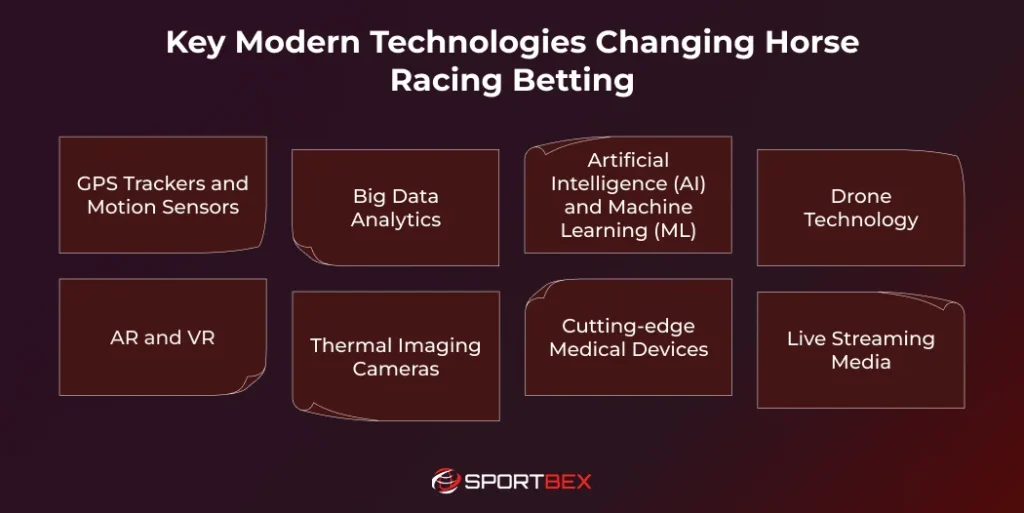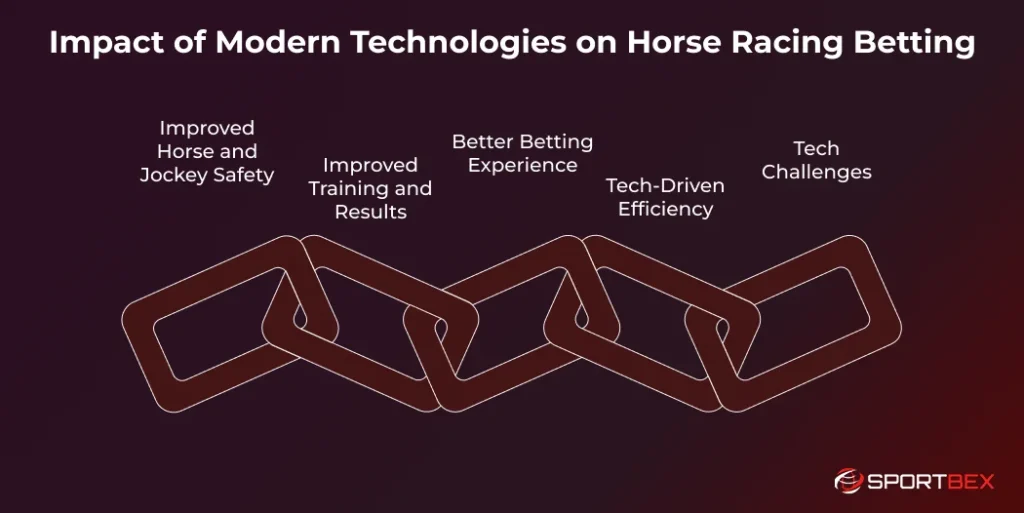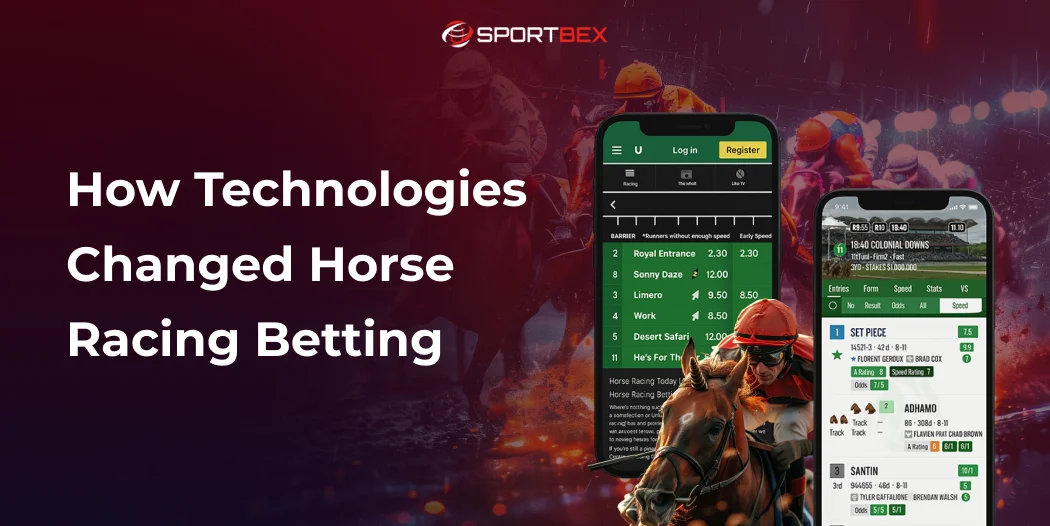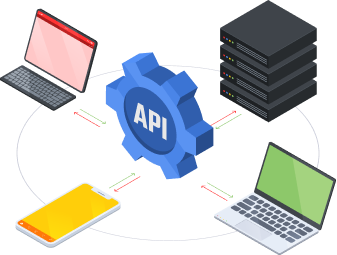Horse racing has been popular for many years because of its fast-paced races and betting. But today, it’s more than just a traditional sport. New technologies like GPS trackers, AI tools, and real-time data are changing how people place bets and enjoy horse racing.
Today’s technology is transforming every part of horse racing—not just how we bet. Horse racing API now deliver real-time data that trainers use for performance analytics, while bettors rely on these APIs for instant insights and smarter wagering decisions.
Whether you’re a racing fan, casual bettor, or part of the industry, understanding modern horse racing technology is more important than ever. How Technologies Changed Horse Racing Betting is clear when we look at tools like tracking systems that improve training and AI algorithms that help calculate smarter odds. Technology is truly reshaping the way we bet on and experience the sport.
What is Horse Racing Betting?
Horse racing betting represents one of the world’s oldest forms, where punters wager money on the outcome of horse races. At its core, it involves predicting which horse will finish first, second, or third in a race, though modern betting has expanded far beyond these simple win, place, and show.
The fundamental concept revolves around odds—numerical representations of a horse’s likelihood of winning based on various factors, including past performance, jockey skill, track conditions, and public betting patterns. These odds determine potential payouts, with less favoured horses offering higher returns for successful bets.
Traditional horse racing betting took place exclusively at racetracks, with bookmakers calling out odds and accepting bets in person.
How Technology Works in Horse Racing Betting
Technology’s integration into horse racing betting operates across multiple interconnected layers, creating a comprehensive ecosystem that enhances every aspect of the wagering experience.
The foundation begins with data collection, where sophisticated sensors and tracking devices gather real-time information about horses, jockeys, track conditions, and environmental factors during races and training sessions.
This valuable data is then processed and distributed through the sports data API, enabling platforms and betting systems to deliver accurate, up-to-date insights to users.
This raw data flows into powerful processing systems that employ advanced algorithms to analyse patterns, calculate probabilities, and generate insights. Sports data technology platforms aggregate information from multiple sources, creating comprehensive databases that track everything from individual horse performance metrics to broader racing trends across different venues and conditions.
Key Modern Technologies Changing Horse Racing Betting

GPS Trackers and Motion Sensors
GPS tracking technology has revolutionised how we understand horse movement and performance during races and training sessions. These lightweight devices, typically weighing less than 100 grams, attach securely to horses without impeding their natural movement or causing discomfort.
Modern GPS trackers capture position data at frequencies up to 20 times per second, providing incredibly detailed information about speed variations, acceleration patterns, and positional changes throughout a race.
This granular data reveals insights that were previously impossible to obtain, such as how horses respond to different parts of the track, their energy expenditure patterns, and optimal positioning strategies.
Big Data Analytics
Horse racing now has access to a huge amount of data, which means smarter tools are needed to understand it. Big data analytics platforms, powered by horse racing data API, can now study millions of details from each race — like past results, weather, track conditions, horse breeding, and live health data — all at once to help make better decisions.
These systems employ complex statistical models to identify patterns and correlations that human analysts might miss. For example, analytics can reveal that certain horses perform exceptionally well on tracks with specific moisture levels, or that particular jockey-horse combinations have higher success rates under certain weather conditions.
Artificial Intelligence (AI) and Machine Learning (ML)
AI in horse racing represents perhaps the most transformative technological advancement in the sport’s modern era. Machine learning algorithms can process enormous datasets to identify complex patterns and relationships that would be impossible for human analysts to detect manually.
These systems continuously learn from new data, refining their predictive models with each race result. Unlike static analytical tools, AI algorithms adapt to changing conditions, seasonal variations, and evolving competitive dynamics within the sport.
Drone Technology
Drones have added a new way to look at horse racing. These flying cameras capture clear, high-up views of the race, helping experts and fans see how horses move, where they position themselves, and how the track is being used.
Drone technology enables comprehensive track condition monitoring, identifying variations in surface moisture, texture, and firmness across different sections of the racecourse. This information helps trainers and bettors understand how track conditions might favour certain running styles or positions.
AR and VR
Augmented reality (AR) and virtual reality (VR) are changing how people enjoy horse racing. With AR, fans at the track can use their phones to see live stats, updated odds, and other race info right on their screens, making the experience more exciting and interactive.
Virtual reality creates immersive experiences that bring the excitement of major races to bettors regardless of their physical location. High-quality VR broadcasts allow users to experience races from multiple perspectives, including jockey-view simulations that provide unprecedented insight into race tactics and decision-making.
Thermal Imaging Cameras
Thermal imaging technology provides non-invasive methods for monitoring horse health and performance conditions. These sophisticated cameras detect heat patterns that can indicate muscle tension, circulation issues, or potential injury sites before they become visible through conventional observation.
Pre-race thermal scans help identify horses that might be experiencing physical stress or discomfort that could impact their performance. This information is valuable for trainers making last-minute decisions about race participation and for bettors assessing the true condition of competing horses.
Cutting-edge Medical Devices
Modern veterinary technology helps keep racehorses healthy and in top shape. Tools like portable ultrasound machines, digital X-rays, and advanced blood tests give trainers a clear picture of a horse’s health. This helps them make smart choices about training and racing.
Wearable heart rate monitors track cardiovascular responses during training and racing, providing objective measures of fitness levels and recovery rates. This data helps identify optimal training intensities and recovery periods for individual horses.
Live Streaming Media
High-quality live streaming has made it easy for people everywhere to watch horse races from around the world. Now, bettors can follow and bet on races in real-time, not just at their local tracks.
Multi-angle camera systems provide comprehensive race coverage, allowing viewers to observe tactics, positioning, and performance from multiple perspectives simultaneously. This enhanced coverage provides valuable analytical information that supports more informed betting decisions.
Impact of Modern Technologies on Horse Racing Betting

Improved Horse and Jockey Safety
One of the biggest benefits of modern technology in horse racing is better safety for both horses and jockeys. Today’s smart monitoring tools can check a horse’s health in real-time, helping catch problems early and reduce the risk of serious injuries.
Wearable sensors continuously monitor vital signs, detecting irregularities in heart rate, breathing patterns, or movement that might indicate distress or developing health issues. These early warning systems enable immediate intervention, potentially preventing catastrophic injuries that could prove fatal.
Track surface monitoring technology ensures optimal racing conditions by providing precise measurements of ground firmness, moisture content, and surface consistency. Automated systems can detect dangerous variations that might create hazardous conditions, allowing officials to postpone races or modify track preparation procedures.
Improved Training and Results
Modern technology has changed how horses are trained for races. Trainers now use smart tracking systems to measure a horse’s fitness, recovery, and progress. This data helps them make better training decisions and improve performance.
Biomechanical analysis reveals optimal running techniques for individual horses, enabling trainers to modify gait patterns and improve efficiency. This personalised approach to training maximises each horse’s natural abilities while minimising stress and injury risk.
Nutritional monitoring systems track feeding patterns, weight changes, and metabolic responses to different dietary regimens. This data helps optimise nutrition programs for peak performance while maintaining long-term health and career longevity.
Better Betting Experience
Technology has made horse racing betting smarter and more accurate. With powerful tools and data, people can now study horse stats, race history, and odds before placing bets—making the experience more reliable while keeping the excitement alive.
Horse betting sites now offer user-friendly interfaces that turn complex data into clear, easy-to-read information. With interactive charts, predictive tools, and custom alerts, even casual bettors can access insights once reserved for professionals.
Sports betting APIs enable wagering from anywhere, expanding participation opportunities and creating more dynamic betting markets. Real-time odds updates, instant bet placement, and immediate result notifications provide seamless user experiences that rival traditional trackside betting.
Tech-Driven Efficiency
Automation has made horse racing smoother and faster. It helps with tasks like race entry, scheduling, result updates, and payouts. This reduces mistakes, saves time and money, and makes the betting experience quicker and more efficient for everyone.
Digital race entries eliminate paperwork delays and reduce administrative errors that could impact race scheduling or field composition. Automated systems can process entries, verify eligibility, and generate race programs more quickly and accurately than manual processes.
Real-time data processing enables instant odds adjustments based on betting patterns, late scratches, or changing conditions. This responsiveness ensures that odds accurately reflect current circumstances and maintain fair betting opportunities.
Tech Challenges
Even with many benefits, using technology in horse racing betting still has challenges. One big issue is making sure the data is accurate. Since betting systems rely on this information, any mistakes in the data can lead to wrong predictions or results.
Equipment failures or connectivity issues can disrupt data collection during crucial moments, potentially affecting race analysis or betting decisions. Backup systems and redundancy measures are essential, but they add complexity and cost to technological implementations.
Privacy concerns arise from extensive data collection about horses, trainers, jockeys, and bettors. Balancing the need for comprehensive information with appropriate privacy protection requires careful consideration and robust security measures.
Get a Ready-Made Platform On Rent.
Get Started Today
Conclusion
Technology in horse racing is still growing fast. In the future, we’ll see even smarter tools like AI, better data predictions, and more exciting ways for fans to watch and bet. New technology will continue to change how we enjoy and understand the sport.
Technology is changing the way we enjoy and bet on horse racing. From live data to smarter predictions, everything is faster, more accurate, and easier to access.
The future of horse racing lies in this digital shift, where innovation continues to improve both the betting experience and the sport itself. With Horse Racing API integration, apps and platforms can now offer real-time race updates, betting odds, and detailed insights in just a few clicks.
This means fans and bettors can follow horse racing events from anywhere in the world and make better decisions using trusted data. Whether you’re building a sports betting site or just love the sport, using the right APIs can give you a major advantage.
Frequently Asked Questions
Technology has made betting faster, smarter, and more data-driven. Tools like AI, GPS tracking, and real-time stats help bettors make more informed decisions and improve the overall experience.
AI helps predict race outcomes by analyzing large amounts of data, such as horse performance history, jockey stats, and weather conditions. This leads to more accurate odds and smarter betting strategies.
Yes, many horse betting sites and apps now offer real-time updates, live streaming, betting options, and race analytics—all in one place, making betting easier and more convenient.
GPS trackers monitor a horse’s speed, position, and performance during training and races. This data helps trainers improve strategies and gives bettors better insights before placing bets.
Yes, virtual and augmented reality enhance the viewing and betting experience by offering immersive race simulations, 3D visuals, and interactive features for fans and bettors.
Recent Blog
Live Casino API Providers in India
July 25, 2025
 9 min
9 min
Greyhound Data API vs Manual Feed: Which One Is Right?
July 25, 2025
 8 min
8 min








